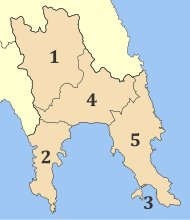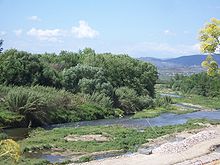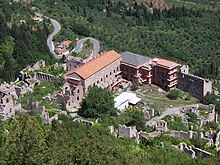Laconia
Laconia
Περιφερειακή ενότητα Λακωνίας | |
|---|---|
 Municipalities of Laconia | |
| Coordinates: 37°00′N 22°30′E / 37.0°N 22.5°E | |
| Country | Greece |
| Administrative region | Peloponnese |
| Seat | Sparta |
| Area | |
• Total | 3,636 km2 (1,404 sq mi) |
| Population (2021)[1] | |
• Total | 84,337 |
| • Density | 23/km2 (60/sq mi) |
| Demonym | Laconian(s) |
| Time zone | UTC+2 (EET) |
| • Summer (DST) | UTC+3 (EEST) |
| Postal code | 23x xx |
| Area code(s) | 273x0 |
| Vehicle registration | ΑΚ |
Laconia or Lakonia (Greek: Λακωνία, Lakonía, [lakoˈni.a]) is a historical and administrative region of Greece located on the southeastern part of the Peloponnese peninsula. Its administrative capital is Sparta. The word laconic—to speak in a blunt, concise way—is derived from the name of this region, a reference to the ancient Spartans who were renowned for their verbal austerity and blunt, often pithy remarks.
Geography
[edit]
Laconia is bordered by Messenia to the west and Arcadia to the north and is surrounded by the Myrtoan Sea to the east and by the Laconian Gulf and the Mediterranean Sea to the south. It encompasses Cape Malea and Cape Tainaron and a large part of the Mani Peninsula. The Mani Peninsula is in the west region of Laconia.[2] The islands of Kythira and Antikythera lie to the south, but they administratively belong to the Attica regional unit of islands. The island, Elafonisos, situated between the Laconian mainland and Kythira, is part of Laconia.
The Evrotas is the longest river in the prefecture. The Evrotas Valley is predominantly an agricultural region that contains many citrus groves, olive groves, and pasture lands. It is the location of the largest orange production in the Peloponnese and probably in all of Greece. Lakonia, a brand of orange juice, is based in Amykles.
The main mountain ranges are the Taygetus 2,407 m (7,897 ft) in the west and the Parnon 1,961 m (6,434 ft) in the northeast. Taygetus, known as Pentadaktylos (five-fingers) throughout the Middle Ages, is west of Sparta and the Evrotas Valley. It is the highest mountain in Laconia and the Peloponnese and is mostly covered with pine trees. Two roads join the Messenia and Laconia prefectures: one is a tortuous mountain pass through Taygetus and the other bypasses the mountain via the Mani district to the south.
The stalactite cave, Dirou, a major tourist attraction, is located south of Areopolis in the southwest of Laconia.
Climate
[edit]The city of Sparta enjoys a sunny and warm Mediterranean climate (Köppen: Csa). January highs are around 14 °C (57 °F) while July and August highs are around 36 °C (97 °F) in the city proper. Sparta records the highest summer average maximum temperatures in Greece.[3] In July 2012 the city registered an average maximum temperature of 38.3 °C (100.9 °F), making it Greece's second highest monthly average maximum temperature to date after the 38.6 °C (101.5 °F) recorded in Stylida in July 2023.[4][5] The highest temperature ever recorded in Sparta is 45.7 °C (114.3 °F) in August 2021.[6] On average, Sparta records 5 days per year with temperatures of over 40.0 °C (104.0 °F).[7]
| Climate data for Sparta (2009–2024) | |||||||||||||
|---|---|---|---|---|---|---|---|---|---|---|---|---|---|
| Month | Jan | Feb | Mar | Apr | May | Jun | Jul | Aug | Sep | Oct | Nov | Dec | Year |
| Record high °C (°F) | 23.5 (74.3) |
26.4 (79.5) |
27.2 (81.0) |
34.1 (93.4) |
40.7 (105.3) |
44.4 (111.9) |
44.2 (111.6) |
45.7 (114.3) |
40.3 (104.5) |
36.4 (97.5) |
30.8 (87.4) |
23.5 (74.3) |
45.7 (114.3) |
| Mean daily maximum °C (°F) | 14.4 (57.9) |
16.1 (61.0) |
18.4 (65.1) |
22.8 (73.0) |
27.8 (82.0) |
32.5 (90.5) |
36.0 (96.8) |
35.9 (96.6) |
31.3 (88.3) |
25.3 (77.5) |
20.2 (68.4) |
16.1 (61.0) |
24.7 (76.5) |
| Daily mean °C (°F) | 8.8 (47.8) |
10.0 (50.0) |
12.0 (53.6) |
15.4 (59.7) |
20.0 (68.0) |
24.6 (76.3) |
27.7 (81.9) |
27.7 (81.9) |
23.8 (74.8) |
18.5 (65.3) |
14.1 (57.4) |
10.2 (50.4) |
17.7 (63.9) |
| Mean daily minimum °C (°F) | 3.1 (37.6) |
4.0 (39.2) |
5.6 (42.1) |
8.0 (46.4) |
12.2 (54.0) |
16.7 (62.1) |
19.5 (67.1) |
19.6 (67.3) |
16.4 (61.5) |
11.8 (53.2) |
7.9 (46.2) |
4.4 (39.9) |
10.8 (51.4) |
| Record low °C (°F) | −5.3 (22.5) |
−4.2 (24.4) |
−4.6 (23.7) |
−0.7 (30.7) |
6.2 (43.2) |
9.4 (48.9) |
14.2 (57.6) |
13.1 (55.6) |
9.1 (48.4) |
1.5 (34.7) |
−1.7 (28.9) |
−5.2 (22.6) |
−5.3 (22.5) |
| Average rainfall mm (inches) | 122.6 (4.83) |
82.3 (3.24) |
62.4 (2.46) |
33.1 (1.30) |
24.8 (0.98) |
35.3 (1.39) |
11.9 (0.47) |
19.0 (0.75) |
52.2 (2.06) |
61.5 (2.42) |
88.1 (3.47) |
92.0 (3.62) |
685.2 (26.99) |
| Source: National Observatory of Athens (Feb 2009 - Feb 2024),[8][9] Sparta N.O.A station,[10] World Meteorological Organization[11] | |||||||||||||
| Climate data for Sparta Air Base (HNMS ,1974–2004) | |||||||||||||
|---|---|---|---|---|---|---|---|---|---|---|---|---|---|
| Month | Jan | Feb | Mar | Apr | May | Jun | Jul | Aug | Sep | Oct | Nov | Dec | Year |
| Mean daily maximum °C (°F) | 14.4 (57.9) |
15.1 (59.2) |
17.7 (63.9) |
21.3 (70.3) |
27.0 (80.6) |
32.2 (90.0) |
34.8 (94.6) |
34.3 (93.7) |
30.5 (86.9) |
25.7 (78.3) |
19.4 (66.9) |
15.2 (59.4) |
24.0 (75.1) |
| Daily mean °C (°F) | 9.6 (49.3) |
10.2 (50.4) |
12.4 (54.3) |
15.8 (60.4) |
21.2 (70.2) |
26.2 (79.2) |
28.5 (83.3) |
27.8 (82.0) |
24.2 (75.6) |
19.6 (67.3) |
14.2 (57.6) |
10.8 (51.4) |
18.4 (65.1) |
| Mean daily minimum °C (°F) | 3.5 (38.3) |
3.8 (38.8) |
5.5 (41.9) |
7.6 (45.7) |
11.8 (53.2) |
15.9 (60.6) |
18.7 (65.7) |
18.0 (64.4) |
15.3 (59.5) |
12.3 (54.1) |
8.2 (46.8) |
5.1 (41.2) |
10.5 (50.9) |
| Average rainfall mm (inches) | 90.7 (3.57) |
84.6 (3.33) |
73.3 (2.89) |
66.0 (2.60) |
47.4 (1.87) |
14.6 (0.57) |
18.8 (0.74) |
26.4 (1.04) |
30.8 (1.21) |
54.6 (2.15) |
90.0 (3.54) |
107.9 (4.25) |
705.1 (27.76) |
| Source: Meteoclub.gr[12] | |||||||||||||
History
[edit]Ancient
[edit]
Evidence of Neolithic settlement in southern Laconia has been found during excavations of the Alepotrypa cave site.[13] Significant archaeological recovery exists at the Vaphio-tomb site in Laconia. Found there is advanced Bronze Age art as well as evidence of cultural associations with the contemporaneous Minoan culture on Crete.[14] At the end of the Mycenean period, the population of Laconia sharply declined.[15] In classical Greece, Laconia was Spartan territory but from the 4th century BC onward Sparta lost control of various ports, towns and areas.[16][17] From the mid-2nd century BC until 395 AD, Laconia was a part of the Roman Empire.
Medieval
[edit]
In the medieval period, Laconia formed part of the Byzantine Empire. In the 7th century, Slavic tribes settled in the Peloponnese. Two of them, the Melingoi and the Ezeritai, who settled in parts of Laconia, survived the subsequent Byzantine reconquest and re-Hellenization of the Peloponnese, and are attested until the late Middle Ages.
Following the Fourth Crusade, Laconia was gradually conquered by the Frankish Principality of Achaea. In the 1260s, the Byzantines recovered Mystras and other fortresses in the region and managed to evict the Franks from Laconia, which became the nucleus of a new Byzantine province. By the mid-14th century, this evolved into the Despotate of the Morea, held by the last Greek ruling dynasty, the Palaiologoi. The capital of the Despotate, Mystras, was a major site of the Palaiologan Renaissance, the last flowering of Byzantine culture. With the fall of the Despotate to the Ottomans in 1460, Laconia was conquered as well.
Modern
[edit]With the exception of a 30-year interval of Venetian rule, Laconia remained under Ottoman control until the outbreak of the Greek War of Independence of 1821. Following independence, Sparta was selected as the capital of the modern prefecture, and its economy and agriculture expanded. With the incorporation of the British-ruled Ionian Islands into Greece in 1864, Elafonissos became part of the prefecture. After World War II and the Greek Civil War, its population began to somewhat decline, as people moved from the villages toward the larger cities of Greece and abroad.
In 1992, a devastating fire ruined the finest olive crops in the northern part of the prefecture, and affected the area of Sellasia along with Oinountas and its surrounding areas. Firefighters, helicopters and planes battled for days to put out the horrific fire.
In early 2006, flooding ruined olive and citrus crops as well as properties and villages along the Eurotas river. In the summer 2006, a fire devastated a part of the Mani Peninsula, ruining forests, crops, and numerous villages.
Municipalities
[edit]



The regional unit, Laconia, is subdivided into five municipalities. These are (number as in the map in the infobox):[18]
- East Mani (Anatoliki Mani, 2)
- Elafonisos (3)
- Eurotas (4)
- Monemvasia (5)
- Sparta (1)
Prefecture
[edit]As a part of the 2011 Kallikratis government reform, regional unit Laconia was created out of the former prefecture Laconia (Greek: Νομός Λακωνίας). The prefecture had the same territory as the present regional unit. At the same time, the municipalities were reorganised, according to the table below.[18]
| New municipality | Old municipalities | Seat |
|---|---|---|
| East Mani (Anatoliki Mani) |
East Mani | Gytheio |
| Gytheio | ||
| Oitylo | ||
| Sminos | ||
| Elafonisos | Elafonisos | Elafonisos |
| Eurotas | Skala | Skala |
| Geronthres | ||
| Elos | ||
| Krokees | ||
| Niata | ||
| Monemvasia | Monemvasia | Molaoi |
| Asopos | ||
| Voies | ||
| Zarakas | ||
| Molaoi | ||
| Sparti | Sparti | Sparti |
| Therapnes | ||
| Karyes | ||
| Mystras | ||
| Oinountas | ||
| Pellana | ||
| Faris |
Provinces
[edit]- Epidavros Limira Province – Molaoi
- Gytheio Province – Gytheio
- Lacedaemonia Province – Sparti
- Oitylo Province – Areopoli
Note: Provinces no longer hold any legal status in Greece.
Population
[edit]| Year | Pop. | ±% |
|---|---|---|
| 1907 | 87,106 | — |
| 1991[19] | 90,600 | +4.0% |
| 2001[19] | 92,811 | +2.4% |
| 2011[19] | 89,138 | −4.0% |
| 2021[1] | 84,337 | −5.4% |
The main cities and towns of Laconia are (ranked by 2021 census population):
Transport
[edit]- Greek National Road 39, Tripoli – Sparti – Gytheio
- Greek National Road 82, Pylos – Kalamata – Sparti
- Greek National Road 86, Gytheio – Monemvasia
- Molaoi to Leonidi Road, E, NE
Communications
[edit]Radio
[edit]- FLY FM 89,7 (Sparta).
- POLITIA 90,7 – ΠΟΛΙΤΕΙΑ 90.7 (Sparta)
- Radio Sparti – 92.7 FM (Sparta)
- Radiofonias Notias Lakonias (Southern Laconia Radio) – 93.5 (Gytheio)
- Star FM – 94.7
Television
[edit]- Ellada TV – UHF 43, Sparta
- TV Notias Lakonias – Molaoi
Newspapers
[edit]- Λακωνικός Τύπος
- Ελεύθερη Άποψη
- Νέα Σπάρτη
- Παρατηρητής της Λακωνίας
See also
[edit]References
[edit]- ^ a b "Αποτελέσματα Απογραφής Πληθυσμού - Κατοικιών 2021, Μόνιμος Πληθυσμός κατά οικισμό" [Results of the 2021 Population - Housing Census, Permanent population by settlement] (in Greek). Hellenic Statistical Authority. 29 March 2024.
- ^ www.thegreektravel.com. "Lakonia Greece, Mani, Monamvassia, Sparti, Gytheio, Mystras, Elafonissos, Gytheio, Hotels in lakonia, activities, travel greece". www.thegreektravel.com. Archived from the original on 27 September 2017. Retrieved 26 September 2017.
- ^ "Meteoclub.gr". Archived from the original on 5 September 2014. Retrieved 5 September 2014.
- ^ "Stylida NOA". Archived from the original on 4 August 2023. Retrieved 4 August 2023.
- ^ "N.O.A July 2012 bulletin" (PDF). Archived from the original (PDF) on 28 February 2013. Retrieved 20 January 2013.
- ^ Deltio data
- ^ "Meteo.gr - Προγνώσεις καιρού για όλη την Ελλάδα". Archived from the original on 2 February 2023. Retrieved 28 November 2023.
- ^ "Climate" (in Greek). National Observatory of Athens. Archived from the original on 27 September 2022.
- ^ "N.O.A Monthly Bulletins". Archived from the original on 2 February 2023. Retrieved 28 November 2023.
- ^ "Latest Conditions in Sparta".
- ^ "World Meteorological Organization". Archived from the original on 12 July 2023. Retrieved 14 July 2023.
- ^ Σπάρτη : H υπερδύναμη της καλοκαιρινής ζέστης στην Ελλάδα (in Greek). Meteoclub. Archived from the original on 5 September 2014. Retrieved 7 June 2016.
- ^ Cartledge, Paul (26 May 2003). The Spartans. The Overlook Press. ISBN 978-1-59020-837-3.
- ^ C. Michael Hogan, Knossos fieldnotes, Modern Antiquarian (2007) Archived 11 July 2018 at the Wayback Machine
- ^ Sarah B. Pomeroy, Stanley M. Burstein and Walter Donlan (1998) Ancient Greece: A Political, Social, and Cultural History, 512 pages, Oxford University Press, ISBN 0-19-509742-4
- ^ Cartledge, Paul (2002). Sparta and Lakonia : a regional history, 1300-362 B.C. (2nd ed.). New York: Routledge. pp. 228–259, 273–277. ISBN 0415262763.
- ^ Cartledge, Paul (2002). Hellenistic and Roman Sparta : a tale of two cities (2nd ed.). London: Routledge. ISBN 0415262771.
- ^ a b "ΦΕΚ A 87/2010, Kallikratis reform law text" (in Greek). Government Gazette. Archived from the original on 18 July 2010. Retrieved 7 September 2021.
- ^ a b c "Απογραφές πληθυσμού 1991,2001,2011 σύμφωνα με την κωδικοποίηση της Απογραφής 2011" (in Greek). Hellenic Statistical Authority. Retrieved 17 April 2024.



